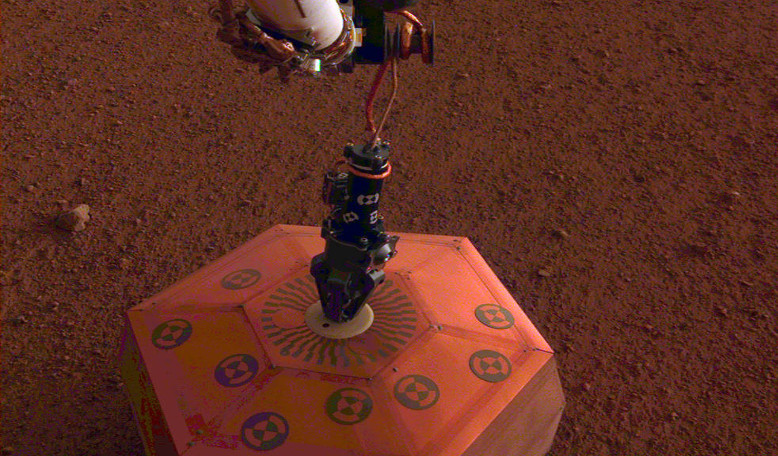Wasting no time at its new home on the Red Planet, NASA’s InSight lander swiftly moves on with the task at hand as it deploys its first instrument onto the surface of Mars.
The instrument is the Seismic Experiment for Interior Structure, or SEIS, for short, a crucial round, dome-shaped instrument which is designed to take the "pulse" or seismic vibrations of Mars. SEIS is the agency’s highest-priority instrument on the lander as it is needed to complete about three-quarters of the science objectives lined up for the mission.
"Seismometer deployment is as important as landing InSight on Mars," said InSight Principal Investigator Bruce Banerdt, who is based at JPL.
SEIS was carefully placed onto the martian surface after a dry run was first completed here on Earth at NASA’s test bed facility based at the agency’s Jet Propulsion Laboratory (JPL) in Pasadena, California.
Like one of NASA's other famous rovers – Curiosity – which is currently drilling holes on the Vera Rubin Ridge, InSight has a full-scale working model, aptly named ForeSight, which allows the team to test all operations on InSight on this planet before they happen on Mars.
ForeSight sits in a martian rock garden at JPL which, based on images sent back from the spacecraft's cameras, has been transformed or 'Marsformed' as the team like to call it, to look like the terrain immediately surrounding the lander.
The images have the added advantage of helping scientists to work out where the landers instruments should be placed. For SEIS and HP3, the best spot happened to be about as far away as the arm can reach — 1.636 meters (5.367 feet) away directly in front of InSight.
"Having the seismometer on the ground is like holding a phone up to your ear," said Philippe Lognonné, principal investigator of SEIS from Institut de Physique du Globe de Paris (IPGP) and Paris Diderot University. "We're thrilled that we're now in the best position to listen to all the seismic waves from below Mars' surface and from its deep interior."
The team’s next job is to level the seismometer, which is sitting on ground that is tilted 2 to 3 degrees. Once angled in the right position, SEIS will start to listen out for marsquakes – thunderous seismic waves that emanate throughout Mars’ layered interior.
Like on Earth, heavy elements on Mars have sunk to its centre in a process known as differentiation, resulting in a dense, metallic core region overlaid by less dense materials. Scientists will use marsquakes to deduce the depth and composition of these layers and see if they match up to model predictions of the planet’s interior.
There is still a few weeks before it can start gathering reliable data however, as the team behind the instrument will have to check and possibly adjust the seismometer's long, wire-lined tether to minimise any noise that could travel along it to the seismometer.
Then, at the start of next year in early January, the seismometer should be protected from the often wild weather that sweeps across Mars as the instrument’s Wind and Thermal Shield is placed over it to guard its sensors.
If everything goes to plan, then in late January, InSight’s Heat Flow and Physical Properties Probe (HP3), will be next on the list for deployment to the surface. HP3 will occupy a position to the east of the lander, roughly the same distance away from the lander as the seismometer.
In the mean time though, everyone is focusing on getting the first streams of seismic data back from the Martian surface, however noisy they might happen to be.
"We look forward to popping some Champagne when we start to get data from InSight's seismometer on the ground," Banerdt added. "I have a bottle ready for the occasion."











